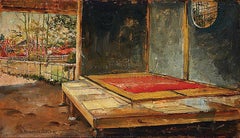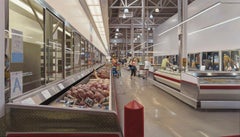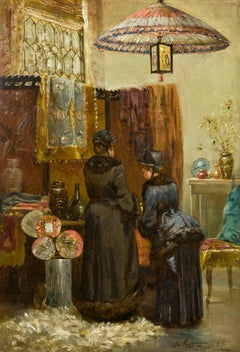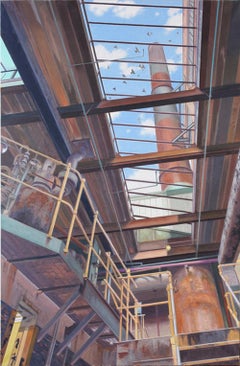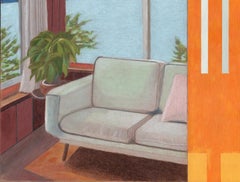Hirschl & Adler Interior Paintings
to
8
1
5
3
2
1
1
4
Overall Height
to
Overall Width
to
5
1
4
3
2
2
1
1
1
1
1
1
1
1
1
1
1
3
5
3
2
1
1
1
8
8
4
4
3
Interior of a Japanese House
By Harry Humphrey Moore
Located in New York, NY
Harry Humphrey Moore led a cosmopolitan lifestyle, dividing his time between Europe, New York City, and California. This globe-trotting painter was also active in Morocco, and most importantly, he was among the first generation of American artists to live and work in Japan, where he depicted temples, tombs, gardens, merchants, children, and Geisha girls. Praised by fellow painters such as Thomas Eakins, John Singer Sargent, and Jean-Léon Gérôme, Moore’s fame was attributed to his exotic subject matter, as well as to the “brilliant coloring, delicate brush work [sic] and the always present depth of feeling” that characterized his work (Eugene A. Hajdel, Harry H. Moore, American 19th Century: Collection of Information on Harry Humphrey Moore, 19th Century Artist, Based on His Scrap Book and Other Data [Jersey City, New Jersey: privately published, 1950], p. 8).
Born in New York City, Moore was the son of Captain George Humphrey, an affluent shipbuilder, and a descendant of the English painter, Ozias Humphrey (1742–1810). He became deaf at age three, and later went to special schools where he learned lip-reading and sign language. After developing an interest in art as a young boy, Moore studied painting with the portraitist Samuel Waugh in Philadelphia, where he met and became friendly with Eakins. He also received instruction from the painter Louis Bail in New Haven, Connecticut. In 1864, Moore attended classes at the Mark Hopkins Institute in San Francisco, and until 1907, he would visit the “City by the Bay” regularly.
In 1865, Moore went to Europe, spending time in Munich before traveling to Paris, where, in October 1866, he resumed his formal training in Gérôme’s atelier, drawing inspiration from his teacher’s emphasis on authentic detail and his taste for picturesque genre subjects. There, Moore worked alongside Eakins, who had mastered sign language in order to communicate with his friend. In March 1867, Moore enrolled at the prestigious École des Beaux-Arts, honing his drawing skills under the tutelage of Adolphe Yvon, among other leading French painters.
In December 1869, Moore traveled around Spain with Eakins and the Philadelphia engraver, William Sartain. In 1870, he went to Madrid, where he met the Spanish painters Mariano Fortuny and Martin Rico y Ortega. When Eakins and Sartain returned to Paris, Moore remained in Spain, painting depictions of Moorish life in cities such as Segovia and Granada and fraternizing with upper-crust society. In 1872, he married Isabella de Cistue, the well-connected daughter of Colonel Cistue of Saragossa, who was related to the Queen of Spain. For the next two-and-a-half years, the couple lived in Morocco, where Moore painted portraits, interiors, and streetscapes, often accompanied by an armed guard (courtesy of the Grand Sharif) when painting outdoors. (For this aspect of Moore’s oeuvre, see Gerald M. Ackerman, American Orientalists [Courbevoie, France: ACR Édition, 1994], pp. 135–39.) In 1873, he went to Rome, spending two years studying with Fortuny, whose lively technique, bright palette, and penchant for small-format genre scenes made a lasting impression on him. By this point in his career, Moore had emerged as a “rapid workman” who could “finish a picture of given size and containing a given subject quicker than most painters whose style is more simple and less exacting” (New York Times, as quoted in Hajdel, p. 23).
In 1874, Moore settled in New York City, maintaining a studio on East 14th Street, where he would remain until 1880. During these years, he participated intermittently in the annuals of the National Academy of Design in New York and the Pennsylvania Academy of the Fine Arts in Philadelphia, exhibiting Moorish subjects and views of Spain. A well-known figure in Bay Area art circles, Moore had a one-man show at the Snow & May Gallery in San Francisco in 1877, and a solo exhibition at the Bohemian Club, also in San Francisco, in 1880. Indeed, Moore fraternized with many members of the city’s cultural elite, including Katherine Birdsall Johnson (1834–1893), a philanthropist and art collector who owned The Captive (current location unknown), one of his Orientalist subjects. (Johnson’s ownership of The Captive was reported in L. K., “A Popular Paris Artist,” New York Times, July 23, 1893.) According to one contemporary account, Johnson invited Moore and his wife to accompany her on a trip to Japan in 1880 and they readily accepted. (For Johnson’s connection to Moore’s visit to Japan, see Emma Willard and Her Pupils; or, Fifty Years of Troy Female Seminary [New York: Mrs. Russell Sage, 1898]. Johnson’s bond with the Moores was obviously strong, evidenced by the fact that she left them $25,000.00 in her will, which was published in the San Francisco Call on December 10, 1893.) That Moore would be receptive to making the arduous voyage across the Pacific is understandable in view of his penchant for foreign motifs. Having opened its doors to trade with the West in 1854, and in the wake of Japan’s presence at the Philadelphia Centennial Exposition of 1876, American artists were becoming increasingly fascinated by what one commentator referred to as that “ideal dreamland of the poet” (L. K., “A Popular Paris Artist”).
Moore, who was in Japan during 1880–81, became one of the first American artists to travel to the “land of the rising sun,” preceded only by the illustrator, William Heime, who went there in 1851 in conjunction with the Japanese expedition of Commodore Matthew C. Perry; Edward Kern, a topographical artist and explorer who mapped the Japanese coast in 1855; and the Boston landscapist, Winckleworth Allan Gay, a resident of Japan from 1877 to 1880. More specifically, as William H. Gerdts has pointed out, Moore was the “first American painter to seriously address the appearance and mores of the Japanese people” (William H. Gerdts, American Artists in Japan, 1859–1925, exhib. cat. [New York: Hollis Taggart Galleries, 1996], p. 5).
During his sojourn in Nippon (which means, “The Land of the Rising Sun”), Moore spent time in locales such as Tokyo, Yokohama, Kyoto, Nikko, and Osaka, carefully observing the local citizenry, their manners and mode of dress, and the country’s distinctive architecture. Working on easily portable panels, he created about sixty scenes of daily life, among them this depiction of an interior of a dwelling. The location of the view is unknown, but the presence of a rustic rail fence demarcating a yard bordering a distant house flanked by tall trees, shrubs and some blossoming fruit trees, suggests that the work likely portrays a building in a city suburb or a small village.
In his book, Japanese Homes and Their Surroundings, Edward S. Morse (an American zoologist, orientalist, and “japanophile” who taught at Tokyo Imperial University from 1877 to 1879, and visited Japan again in 1891 and 1882) noted the “openness and accessibility of the Japanese house...
Category
Late 19th Century Interior Paintings
Materials
Oil, Wood Panel
Dye House
By John Moore
Located in New York, NY
Signed and dated (at lower right): MOORE 12
Category
2010s Contemporary Interior Paintings
Materials
Oil
517 East 117th Street
By Marc Trujillo
Located in New York, NY
Every detail in Trujillo’s fast-paced, consumer-driven environments is the result of slow painting, of careful and keen observation, both analytic and synthetic. Trujillo depicts his...
Category
2010s Contemporary Interior Paintings
Materials
Metal
The Japanese Corner
By Elliott Daingerfield
Located in New York, NY
A child of the American South, Elliott Daingerfield was born in Harper’s Ferry, Virginia, and raised in Fayetteville, North Carolina, where his father, C...
Category
19th Century American Impressionist Interior Paintings
Materials
Canvas, Oil
Distant Voices
By John Moore
Located in New York, NY
John Moore was born in St. Louis, MO in 1941. He received a BFA from Washington University in St. Louis (1966) and an MFA from Yale University (1968). Over a career spanning forty ye...
Category
2010s Contemporary Interior Paintings
Materials
Canvas, Oil
Clearing
By John Moore
Located in New York, NY
John Moore was born in St. Louis, MO in 1941. He received a BFA from Washington University in St. Louis (1966) and an MFA from Yale University (1968). Over a career spanning forty ye...
Category
2010s Contemporary Interior Paintings
Materials
Canvas, Oil
Peek-a-Boo
By Seymour Joseph Guy
Located in New York, NY
In the latter half of the nineteenth century and into the first decade of the twentieth, New York City art aficionados could count on finding recent work of Seymour Joseph Guy hanging on the walls of the city’s major galleries. Primarily a genre artist, but also a portraitist, between 1859 and 1908 Guy showed more than seventy works at the National Academy of Design. From 1871 to 1903 he contributed over seventy times to exhibitions at the Century Club. From 1864 to 1887, he sent about forty pictures to the Brooklyn Art Association. A good number of these works were already privately owned; they served as advertisements for other pictures that were available for sale. Some pictures were shown multiple times in the same or different venues. Guy was as easy to find as his canvases were omnipresent. Though he lived at first in Brooklyn with his family and then in New Jersey, from 1863 to his death in 1910 he maintained a studio at the Artist’s Studio Building at 55 West 10th Street, a location that was, for much of that period, the center of the New York City art world.
Guy’s path to a successful career as an artist was by no means smooth or even likely. Born in Greenwich, England, he was orphaned at the age of nine. His early interest in art was discouraged by his legal guardian, who wanted a more settled trade for the young man. Only after the guardian also died was Guy free to pursue his intention of becoming an artist. The details of Guy’s early training in art are unclear. His first teacher is believed to have been Thomas Buttersworth...
Category
19th Century American Realist Figurative Paintings
Materials
Canvas, Oil
John F. Kennedy International Airport
By Marc Trujillo
Located in New York, NY
Every detail in Trujillo’s fast-paced, consumer-driven environments is the result of slow painting, of careful and keen observation, both analytic and synthetic. Trujillo depicts his...
Category
2010s Contemporary Interior Paintings
Materials
Oil, Panel
Related Items
Pixel sur le radiateur, Contemporary Oil Painting, Intimate Interiors, Cat
By Raphaël Renaud
Located in AIX-EN-PROVENCE, FR
Work : Original Oil Painting, Handmade Artwork, Unique Work. Ready to Hang.
Medium : Oil on coated wood.
Artist : Raphaël Renaud
Subject : Pixel sur le radiateur (Title), (EN : Pixe...
Category
21st Century and Contemporary Contemporary Interior Paintings
Materials
Oil, Wood Panel
H 11.82 in W 11.82 in D 1.19 in
Fenêtre sur lac, Original Painting, Still-Life, Interior Scene, Ready to hang
Located in AIX-EN-PROVENCE, FR
Oil painting and Oil based color pencils on Archival Cardboard 2mm - Original Painting and Drawing, Still-Life, Interior, Ready to hang
Work Title : Fenêtre sur lac (EN : Window on lake)
Artist : Gabriel Riesnert...
Category
21st Century and Contemporary Contemporary Interior Paintings
Materials
Cardboard, Oil, Oil Crayon
H 7.88 in W 10.24 in D 0.4 in
White Horse Carousel, 1956 - Original Oil Painting On Linen
Located in Soquel, CA
White Horse Carousel, 1956 - Oil On Canvas
Oil painting of an empty carousel ride, a single white horse gleams in the center. Three doorways are seen to the right, with sunlight ema...
Category
1950s American Impressionist Figurative Paintings
Materials
Oil, Linen
H 18.25 in W 25.25 in D 0.5 in
"Snack Bandit" Oil Painting
Located in Denver, CO
Christy Stallop's (US based) "Snack Bandit" is an oil painting that depicts a Crow wearing a green wrestling mask.
Category
2010s Realist Animal Paintings
Materials
Oil, Wood Panel
Portrait of Artist with Elmo, colorful childhood theme w ironic twist
By Jenny Toth
Located in Brooklyn, NY
This is an oil painting done from life with the artist's young son''s large stuffed red Elmo in repose in front of the mirror.
The painting is both tender and bold. It captures one...
Category
2010s Contemporary Interior Paintings
Materials
Cotton Canvas, Oil
H 12 in W 10 in D 1 in
Mid Century Modern Portrait of Woman in Green Dress Original Oil Painting
By Genevieve Rogers
Located in Soquel, CA
Mid Century Modern Portrait of Woman in Green Dress Original Oil Painting
Evocative mid century modern portrait of woman in green dress by California artist Genevieve Rogers (America...
Category
1960s American Impressionist Figurative Paintings
Materials
Canvas, Oil, Illustration Board
H 21.5 in W 24.5 in D 1 in
Portrait of a Man in Armchair, Mid Century Short Story Illustration
Located in Soquel, CA
Excellent figurative oil painting of a man seated in an armchair with papers strewn about the interior space by Charles Ross Kinghan (American, 1895-1984). A working illustration pai...
Category
1930s American Impressionist Figurative Paintings
Materials
Linen, Oil
H 24 in W 30 in D 0.75 in
"Love.Life.Summer"
Located in VÉNISSIEUX, FR
This artwork makes part of my new period in my artistic expression.
This painting dedicated to "Women" series is a special one since it is all about my strong deep personal transfor...
Category
2010s American Impressionist Figurative Paintings
Materials
Cotton Canvas, Oil
"Happy Family", Mid Century Sepia Figurative Interior Scene, Illustration Art
Located in Soquel, CA
"Happy Family", Mid Century Sepia Figurative Interior Scene, Illustration Art by Charles Kinghan
A classic and heartwarming mid-century sepia toned figurative interior scene by Charles Ross Kinghan (American, 1895-1984). Circa 1940's. This mid-century piece exemplifies the classic style of illustrations and advertisements from the period, and depicts a family gathered in their living room.
Signed "Kinghan" in the lower right corner. Acquired with other works by the artist.
Displayed in a period giltwood frame.
Linen size: 36"H x 30"W.
Framed size: 45"H x 38.5"W x 2"D.
Charles Ross Kinghan (American, 1895-1984) was born in Anthony, KS on January 18, 1895. A teacher, he moved to Wichita as a teenager and did sign painting for the Western Sign...
Category
Mid-20th Century American Impressionist Figurative Paintings
Materials
Linen, Oil
Love Seat / oil painting of a chair for two
By Elena Zolotnitsky
Located in Burlingame, CA
Love Seat oil painting features a pink chair for two that is painted with oil on mylar with gold leaf that has been mounted to wood. The painting is part...
Category
21st Century and Contemporary Contemporary Still-life Paintings
Materials
Gold Leaf
"Friday Night at the American Hotel" contemporary oil painting, dinner party fun
By Kelly Carmody
Located in Sag Harbor, NY
An oil painting of figures inside The American Hotel, in Sag Harbor, on a busy Friday Night. Kelly Carmody stood outside on the front porch of the Hotel, and painted the indoor scene...
Category
2010s American Impressionist Figurative Paintings
Materials
Panel, Oil
Old Woman and Boy with Candles, Oil on Panel, 1800s
Located in Stockholm, SE
In this painting titled "Old Woman and Boy with Candles" an intriguing scene unfolds before our eyes. An older woman gazes ahead, her eyes shielded from the flickering candlelight, w...
Category
19th Century Old Masters Interior Paintings
Materials
Oil, Wood Panel
